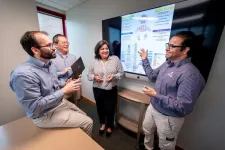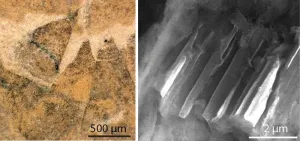(Press-News.org) Scientists at St. Jude Children’s Research Hospital have created a panel that is able to provide a diagnosis for >90% of pediatric cancer patients by sequencing 0.15% of the human genome. The panel is a cost-effective way to test and classify childhood malignancies and to help guide patient treatment. The panel’s performance and validation were published this week in Clinical Cancer Research.
Finding the mutations in a child’s cancer with powerful sequencing technology can lead to better outcomes. Physicians use that knowledge to tailor targeted treatments to the specific cancer-causing mutations affecting each patient. However, current high-end whole genome sequencing requires physical and computational infrastructure that most institutions lack. To address this bottleneck, the St. Jude team developed SJPedPanel, which targets a smaller subset of genes, focusing on those well known to be involved in childhood cancer, instead of looking at the entire genome.
“We have performed clinical genomics for quite a few years and one of the challenges is diagnosing every tumor, especially those with a low percentage of cancer cells in the tested sample.” said co-corresponding author Xiaotu Ma, PhD, St. Jude Department of Computational Biology. “So, we created SJPedPanel as a summary to concentrate most of the genetic knowledge we have gained in the last decade into one smaller test that can be used clinically.”
The proof is in the panel
The group designed the new panel from the beginning for pediatric cancer samples, while other genetic panels were designed for adult cancers and then adapted for children. The scientists also had practical insights into the realities of detecting certain mutations, allowing them to select the most informative genes to include. Those differences led to huge outperformances when compared to existing cancer gene panels.
“We compared this panel with six other commercially available panels,” Ma said. “SJPedPanel provides the most coverage of pediatric cancer driver genes, providing close to 90% when others are closer to 60% coverage.”
That improved performance was the result of dedicated effort. “We performed an iterative optimization of a careful panel design based on our knowledge of pediatric cancer genetics,” said co-corresponding author John Easton, PhD, St. Jude Computational Biology Genomics Laboratory director, who previously served as the leader of the validation laboratory for the Pediatric Cancer Genome Project. “And we pursued that iterative process with the panel manufacturer to ensure its capabilities.”
In addition to working better than adapting adult-focused cancer gene panels, the St. Jude panel can also outperform gold-standard whole genome sequencing in some circumstances. Whole genome sequencing interrogates the entire human genome which makes it difficult to use for the detection of low cell count cancers due to required high-depth sampling.
“There are certain situations, such as low tumor purity samples or even testing after a bone marrow transplantation, where our current clinical whole genome sequencing approach doesn't work,” said co-corresponding author Jeffery Klco, MD, PhD, St. Jude Department of Pathology. “This fills an important clinical gap for our patients.”
Focus on childhood cancer genetics
One reason the panel has had such an immediate impact is its unique nature and origin. St. Jude was one of the hospitals that originated the Pediatric Cancer Genome Project, which sequenced hundreds of patients to provide the most detailed overview of the genomic landscape of pediatric cancer. Prior research focused only on adult cancers, which are genetically distinct from childhood malignancies.
“We've taken all of the knowledge gained from the Pediatric Cancer Genome Project and other sequencing activities within the research space and have used that knowledge to generate this panel, which is now clinically implemented and has been run on over 600 samples in our clinical lab,” said Klco.
That legacy of expertise in childhood cancer genetics will continue to be built upon by incorporating more recent findings into the panel. For example, including the UBTF gene, which was discovered by Klco’s group in 2022. “Clinicians can feel comfortable knowing that the clinical sequencing that we provide to their patients is based on very current research results,” Klco said.
Sharing success to save children
The success of the panel could have real consequences for patients around the world. Correctly diagnosing childhood cancer, and diagnosing it early, can help guide treatment and lead to better outcomes. However, whole genome sequencing requires expensive physical and digital infrastructure. The panel will give institutions without those resources a better chance at identifying those cancers.
“Panels like this are easier for a clinical or research lab to implement into pipelines than whole genome sequencing,” Easton said. “Not every place has the sequencing and analysis capabilities to deal with whole genome. We’ve given the field a more sensitive and practical test.”
While the panel will be commercially available, the St. Jude group also intends to freely share the knowledge of its makeup to help as many children as possible.
“Now that we have this panel, scientists around the world will be able to use it,” Ma said. “The panel is tiny. So, the costs, both sequencing and analytical costs, are going to be minimal and likely viable to use in developing countries and underserved regions.”
“We would be thrilled if more and more centers use this panel for sequencing pediatric cancers,” Klco said, “because we believe it will lead to better patient care and outcomes.”
Authors and funding
The study’s co-first authors are Pandurang Kolekar, Vidya Balagopal and Li Dong, all of St. Jude. The study’s other authors are Joy Nakitandwe, Cleveland Clinic; Yanling Liu, Scott Foy, Quang Tran, Heather Mulder, Anna Huskey, Emily Plyler, Zhikai Liang, Jingqun Ma, Jiali Gu, Maria Namwanje, Jamie Maciaszek, Debbie Payne-Turner, Saradhi Mallampati and Lu Wang, St. Jude.
The study was supported by grants from the National Cancer Institute (R01CA273326), National Institutes of Health (Cancer Center Support Grant P30CA021765) and ALSAC, the fundraising and awareness organization of St. Jude.
Read the full text of the Clinical Cancer Research article:
SJPedPanel: A pan-cancer gene panel for childhood malignancies
St. Jude Children's Research Hospital
St. Jude Children's Research Hospital is leading the way the world understands, treats and cures childhood cancer, sickle cell disease, and other life-threatening disorders. It is the only National Cancer Institute-designated Comprehensive Cancer Center devoted solely to children. Treatments developed at St. Jude have helped push the overall childhood cancer survival rate from 20% to 80% since the hospital opened more than 60 years ago. St. Jude shares the breakthroughs it makes to help doctors and researchers at local hospitals and cancer centers around the world improve the quality of treatment and care for even more children. To learn more, visit stjude.org, read St. Jude Progress, a digital magazine, and follow St. Jude on social media at @stjuderesearch.
END
St. Jude gene panel for pediatric cancers increases access to high-quality testing
Scientists at St. Jude Children’s Research Hospital created a cost-effective, easy-to-use test to categorize a child’s cancer and guide better treatment
2024-08-01
ELSE PRESS RELEASES FROM THIS DATE:
Health insurers have required prior authorization for services for decades—but have they treated patients equitably?
2024-08-01
Prior authorization—the process by which a health insurance company denies or approves coverage for a health care service before the service is performed—became standard practice beginning with Medicare and Medicaid legislation in the 1960s.
Although research has uncovered disparities in prior coverage for cancer patients based on race, little has been known to date on the role of prior authorization in increasing or decreasing these disparities.
To learn more about the issue, Benjamin Ukert, PhD, an assistant professor of health policy and management in the Texas A&M ...
Trying to limit calories? Skip the dip, researchers advise
2024-08-01
UNIVERSITY PARK, Pa. — Snacks provide, on average, about one-fourth of most people’s daily calories. With nearly one in three adults in the United States overweight and more than two in five with obesity, according to the National Institutes of Health, researchers in the Penn State Sensory Evaluation Center are investigating how Americans can snack smarter.
The latest study conducted in the center, housed in the College of Agricultural Sciences, investigated how eating behavior changes when consumers are served a dip with a salty snack. The findings, available online now and to be published in the November issue ...
Innovation Crossroads welcomes seven entrepreneurs for Cohort 2024
2024-08-01
Seven entrepreneurs comprise the next cohort of Innovation Crossroads, a Department of Energy Lab-Embedded Entrepreneurship Program node based at Oak Ridge National Laboratory. The program provides energy-related startup founders from across the nation with access to ORNL’s unique scientific resources and capabilities, as well as connect them with experts, mentors and networks to accelerate their efforts to take their world-changing ideas to the marketplace.
“Supporting the next generation of entrepreneurs is part of ORNL’s ...
American College of Rheumatology opens press registration for ACR Convergence 2024
2024-08-01
FOR IMMEDIATE RELEASE
Aug. 1, 2024
Media Contact:
Monica McDonald
(404) 365-2162
mmcdonald@rheumatology.org
American College of Rheumatology Opens Press Registration for ACR Convergence 2024
ATLANTA – Complimentary press registration is now open for journalists to cover research presented at ACR Convergence 2024, taking place Nov. 14-19 at the Walter E. Washington Convention Center in Washington, D.C. A listing of sessions for the meeting can be found in the online program.
Approved ...
Half a billion-year-old spiny slug reveals the origins of mollusks
2024-08-01
UNDER EMBARGO UNTIL 19:00 BST / 14:00 ET THURSDAY 1 AUGUST 2024
Images available via link in the notes section
Exceptional fossils with preserved soft parts reveal that the earliest molluscs were flat, armoured slugs without shells.
The new species, Shishania aculeata was covered with hollow, organic, cone-shaped spines.
The fossils preserve exceptionally rare detailed features which reveal that these spines were produced using a sophisticated secretion system that is shared with annelids (earthworms and relatives).
A team of researchers including scientists from the University of Oxford have made an astonishing discovery of ...
Award-winning research maps the body’s internal sensory communication highway
2024-08-01
When the question is “how are you feeling on the inside?,” it’s our vagus nerve that offers the answer.
But how does the body’s longest cranial nerve, running from brain to large intestine, encodes sensory information from the visceral organs? For his work investigating and mapping this internal information highway, Qiancheng Zhao is the 2024 grand prize winner of the Science & PINS Prize for Neuromodulation.
Interoception—the body’s ability to sense its internal state in a timely and precise manner—facilitated by the vagus plays a key role in respiratory, gastrointestinal, cardiovascular, endocrine and immune ...
Current Andean glacier loss is unprecedented in the Holocene
2024-08-01
Andean tropical glaciers are experiencing unprecedented retreat, according to a new study that reveals their current sizes are the smallest in over 11,700 years. “Our finding … identifies this region as a hot spot in our understanding of the changing state of the cryosphere,” say the authors. Glaciers act as important indicators of climate change, with their global retreat accelerating over recent decades. Examining this retreat in the context of the previous 11,700 years of the Holocene interglacial highlights the impact of modern global warming. Although many glaciers worldwide are smaller today compared to ...
New fossil resembling a bristly durian fruit reveals insights into the origin of molluscan skeletons
2024-08-01
The early evolution of mollusks has been hard to pin down, but now a newly discovered fossil – of a shell-less, soft-bodied, spiny mollusk from the early Cambrian – provides crucial insights, researchers report. The findings suggest that this fossil, of a creature called Shishania aculeata, is a stem mollusk – representative of an intermediate between early members of the superphylum lophotrochozoans and more derived mollusks. Mollusks are one of the most diverse groups of animals, encompassing various well-known forms such as clams, ...
CLEAR: a new approach to 3D printing materials with highly entangled polymer networks
2024-08-01
Researchers have developed a novel approach to three-dimensional (3D) printing they call “CLEAR,” which significantly improves the strength and durability of materials by using a combination of light and dark chemical reactions to create densely entangled polymer chains. The authors used their approach to print structures with special features, such as the ability to adhere to wet tissues. Incorporation of polymer chain entanglements as reinforcements within 3D printed materials can significantly enhance their mechanical properties. However, traditional vat photopolymerization-based 3D printing techniques, such as digital ...
Genetic insights into how prickles develop across different plants, despite evolutionary separation
2024-08-01
The evolutionary gain and loss of plant prickles – sharp pointed epidermal outgrowths – are controlled by a shared genetic program involving cytokinin biosynthesis, researchers report. The study sheds light on the genetic basis of the emergence of similar traits in distantly related organisms and reveals genomic targets for prickle removal for crop improvement. The genetic basis of trait convergence is a central question in evolutionary biology, and the extent to which it is driven by ...
LAST 30 PRESS RELEASES:
When tropical oceans were oxygen oases
Positive interactions dominate among marine microbes, six-year study reveals
Safeguarding the Winter Olympics-Paralympics against climate change
Most would recommend RSV immunizations for older and pregnant people
Donated blood has a shelf life. A new test tracks how it's aging
Stroke during pregnancy, postpartum associated with more illness, job status later
American Meteorological Society announces new executive director
People with “binge-watching addiction” are more likely to be lonely
Wild potato follows a path to domestication in the American Southwest
General climate advocacy ad campaign received more public engagement compared to more-tailored ad campaign promoting sustainable fashion
Medical LLMs may show real-world potential in identifying individuals with major depressive disorder using WhatsApp voice note recordings
Early translational study supports the role of high-dose inhaled nitric oxide as a potential antimicrobial therapy
AI can predict preemies’ path, Stanford Medicine-led study shows
A wild potato that changed the story of agriculture in the American Southwest
Cancer’s super-enhancers may set the map for DNA breaks and repair: A key clue to why tumors become aggressive and genetically unstable
Prehistoric tool made from elephant bone is the oldest discovered in Europe
Mineralized dental plaque from the Iron Age provides insight into the diet of the Scythians
Salty facts: takeaways have more salt than labels claim
When scientists build nanoscale architecture to solve textile and pharmaceutical industry challenges
Massive cloud with metallic winds discovered orbiting mystery object
Old diseases return as settlement pushes into the Amazon rainforest
Takeaways are used to reward and console – study
Velocity gradients key to explaining large-scale magnetic field structure
Bird retinas function without oxygen – solving a centuries-old biological mystery
Pregnancy- and abortion-related mortality in the US, 2018-2021
Global burden of violence against transgender and gender-diverse adults
Generative AI use and depressive symptoms among US adults
Antibiotic therapy for uncomplicated acute appendicitis
Childhood ADHD linked to midlife physical health problems
Patients struggle to measure blood pressure at home
[Press-News.org] St. Jude gene panel for pediatric cancers increases access to high-quality testingScientists at St. Jude Children’s Research Hospital created a cost-effective, easy-to-use test to categorize a child’s cancer and guide better treatment



